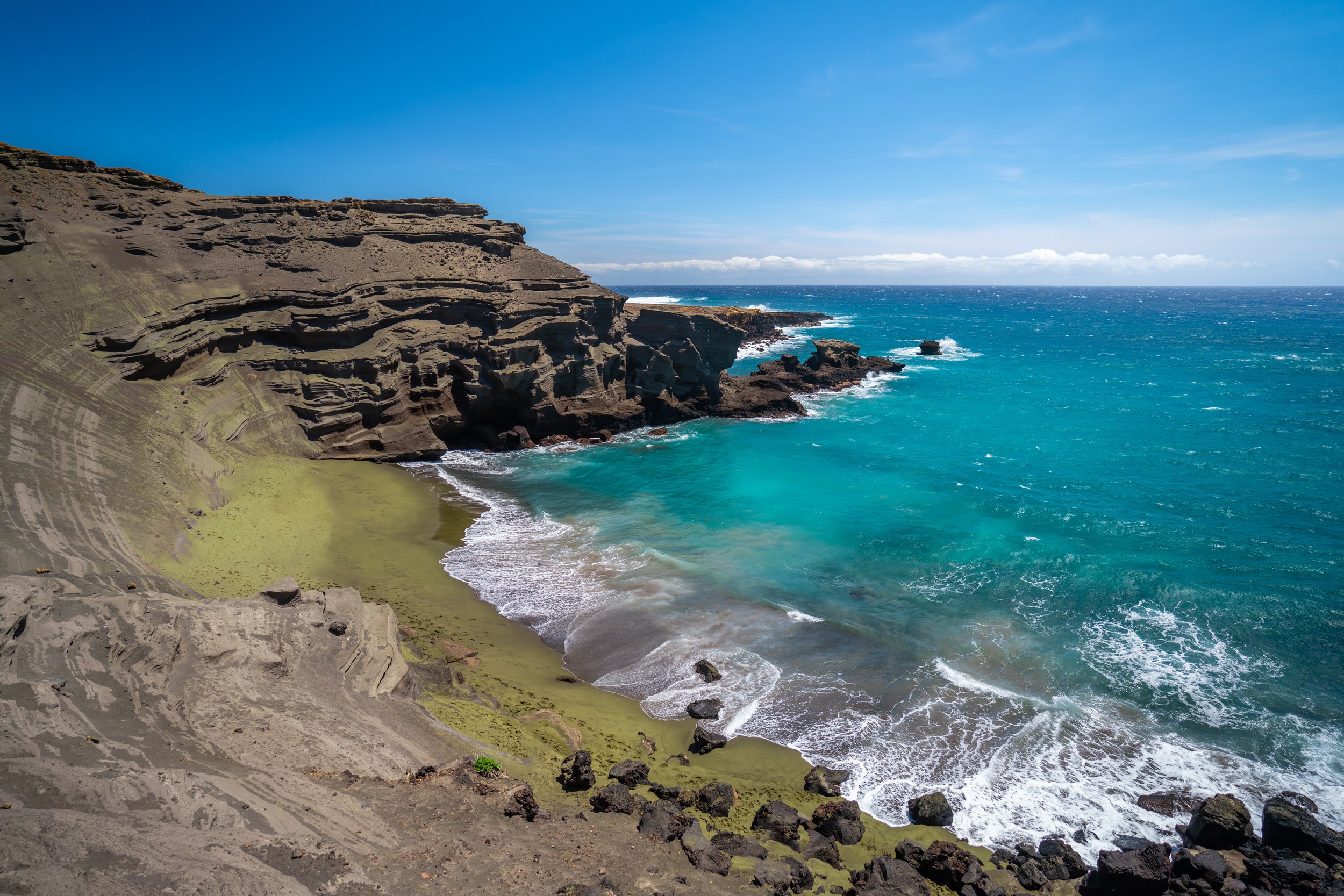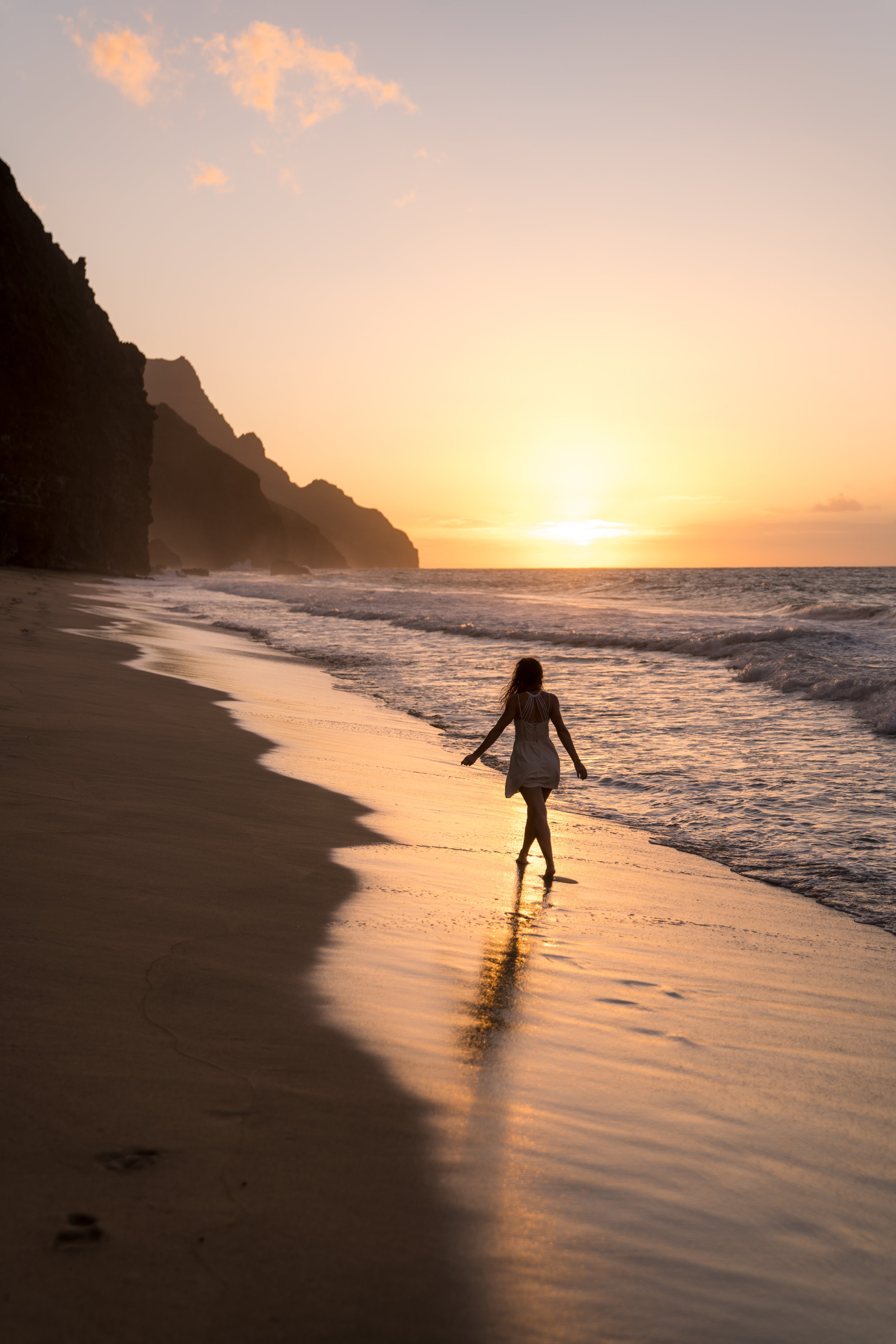Hiking the Puna Trail to Hāʻena Beach on the Big Island of Hawaiʻi
Distance (Roundtrip): 4.8 miles / 7.7 km
The Puna Trail to Hāʻena Beach on the Big Island of Hawaiʻi is about as private and secluded as a publicly accessible beach in Hawaiʻi can get!
I say this because unless you have access to one of the few private properties surrounding Hāʻena Beach, the only way to enjoy the secluded black sand beach is by hiking the 2.4-mile (3.9 km) Puna Trail in Keaʻau.
For this reason, hiking to Hāʻena Beach by way of the Puna Trail is, without a doubt, one of the best things to do on the Big Island—as long as you’re prepared for a typically very muddy adventure through the rainforest!
Puna Trailhead Parking
Parking for the Puna Trail is located at the very end of Beach Road in Keaʻau.
It’s unfortunate that I have to say this, but don’t leave valuables or any bags visible in your vehicle.
Generally speaking, the Puna Trail is a very safe place to visit, but people who get complacent or visitors who don't know any better are easy targets to take advantage of.
Google Maps Directions: Puna Trailhead
My Hawaiʻi Hiking Checklist
Osprey 3L Water Bladder - The Osprey 3L water bladder is the most universal hiking and backpacking water bladder on the market, and it’s my go-to because of the slide-off seal that allows it to be quickly filled from the top. Additionally, individual parts are easily replaceable, such as the bite valve.
Blister / Heel Protectors - I swear by these cheap, amazing heel protectors to prevent blisters for nearly every kind of hiking and backpacking that I do!
Black Diamond Headlamp - Personally, I recommend the Black Diamond Storm because it is one of the brightest, lightest, and longest-lasting headlamps on the market—and trust me, the weight-to-battery-life ratio really does matter!
Hiking / Trail Running Shoes - Depending on the type of trail, I prefer to use either the Keen Targhee for longer, more rugged hiking or the HOKA Zinal Trail-Running Shoe for lighter, less intense trails. In either case, both have been amazing to me for many years across countless environments, and both can be found in men’s and women’s sizes. - (Men’s Keen / Women’s Keen) (Men’s HOKA / Women’s HOKA)
Waterproof Rain Shell - You never know when it may rain, and I’ve learned over the years that a rain shell is far better than a rain jacket. By this, I mean that it’s best to have something that the water will roll right off of, which is why I recommend the Patagonia Torrentshell 3L available in both men’s and women’s sizes.
High SPF Sunscreen - Packing high-SPF sunscreen is a must for long days outside!
Hiking the Puna Trail to Hāʻena Beach
From start to finish, the 2.4-mile (3.9 km) Puna Trail to Hāʻena Beach is an almost entirely flat hike.
That being said, the mud through the rainforest is typically the biggest challenge when making your way out to Hāʻena.
Puna Rainforest
While you might expect a trail on the coast to parallel the ocean, the vast majority of the Puna Trail traverses through a thick rainforest canopy, which begins only 0.2 miles (0.3 km) from the trailhead.
This will essentially continue for the entire hike until the Puna Trail ends at Hāʻena Beach.
Throughout the middle sections of the hike, the Puna Trail crosses over a mix of hard pāhoehoe lava flows, along with very tricky muddy sections to navigate around.
It almost feels as if there’s no consistency between what’s easy or more challenging to hike through.
I’ve always thought that these Banyan trees would make for very beautiful photos when the light is right!
As you start to get closer to Hāʻena Beach, the Puna Trail begins paralleling a few different private properties, which is a nice mental checkpoint, as most of the rainforest can start to look the same.
If you run into this large pool of water on the trail, look to the right toward the ocean, and the trail should continue around toward a much easier crossing.
Hāʻena (Shipman Beach)
After what can feel like an endless hike through the jungle, the Puna Trail suddenly ends at the beautiful Hāʻena Black Sand Beach, also known as Keaʻau or Shipman Beach.
Typically speaking, Hāʻena Beach is one of the most quiet and secluded beaches on the Island of Hawaiʻi, which is why it’s a personal favorite that I love to revisit whenever I can!
Native Plants on the Puna Trail
Overall, the vast majority of the hike on the Puna Trail traverses through a non-native/ invasive Strawberry Guava and Autograph Tree forest.
However, at random points throughout the trail, such as the beginning before the forest and Hāʻena Beach specifically, there are a few native plants to look out for. Some of these include ʻŌhiʻa lehua, Kāwelu grass, Uluhe, ʻUhaloa, Naupaka, ʻIlima, and Niu, to name a few.
If you would like to learn more identifying these and ton of others native Hawaiian plants from across the islands, I encourage you to read more in my separate post.
Read My Separate Post: Native Hawaiian Plant Guide
More Big Island Adventures
If you’re interested in reading about some more amazing Hawaiʻi Island adventures, check out my separate posts below!
Best Hotels & Vacation Rentals on Hawaiʻi Island
Since Hawaiʻi Island is such a big island, I recommend starting your search on VRBO to find places in both Kona and Hilo.
This way, you can plan your adventures on all sides of the island without having to drive too far.
Hawaiʻi Island Airport-Hotel Shuttle
Prices on ride-share apps like Uber/ Lyft cannot beat the price of booking your hotel or vacation rental shuttle prior to arrival.
That being said, the shuttle option below is incredibly cheap, and it’s a great option to get to accommodations across the Kailua-Kona side of the Big Island!
Best Way to Book Rental Cars!
I travel quite a bit, and I know firsthand that finding a good rental car deal can be a challenge, but that’s why I recommend comparing all of your options with Discover Cars.
In short, Discover Cars is a well-known, reputable business that allows you to search for the best deal across companies, and they have the best full-refund cancellation policy I’ve ever seen, valid up to 72, or sometimes even 48, hours prior to your reservation!
Book Here: Discover Cars
Visiting Other Islands
If you are visiting Hawaiʻi Island or heading to another island, check out some of my personal recommendations for Oʻahu, Maui, Kauaʻi, Molokai, Lānaʻi, and Hawaiʻi Island (Big Island) in these separate posts.
If you’re trying to decide which island is right for your visit, check out my overview about each island in the post below.
Read My Separate Post: What is the Best Hawaiian Island to Visit?
What is the Best Time of Year to Visit Hawaiʻi?
The weather in Hawaiʻi can often appear to be warm and beautiful throughout the year, but in my experience, there is a lot more to consider when planning what time of year to visit the islands, such as what island you are considering, what sides of each island do you plan to stay, what activities are you most interested in, the wildlife, and countless other nuanced variables that can all impact the type of trip you can expect to have.
For these reasons, I highly recommend reading through my separate article to not only understand my thoughts regarding the best time of year to come to Hawaiʻi but also what you need to consider based on the time of year that you plan to visit.
Read My Separate Post: What is the Best Time of Year to Visit Hawaiʻi?
Safety
All hikes in Hawaiʻi should not be compared to trails outside of the islands, and hikers should exercise due caution on every adventure, given that many are extremely dangerous.
By this, I mean that Hawaiʻi is known for hot, humid weather, steep, dramatic, and unstable cliffs, and flash floods, which can occur without warning. Therefore, it is important that you check the local forecast, understand the physical condition of your entire group, and pack sufficient food and water before attempting any adventure.
Disclaimer
All information provided on this blog is for informational purposes only and is not intended to be a substitute for information or advice from qualified professionals or managing agencies.
Noah Lang Photography LLC makes no representations or warranties regarding the accuracy or completeness of the information provided here, and readers should use their own discretion, judgement, and seek professional advice where it is appropriate.
Furthermore, Noah Lang Photography LLC shall not be held responsible for any injuries, lost individuals, or legal issues arising from the use of information provided on this website, and if applicable, the above safety disclaimer should be referenced to provide a generic overview of the risks involved.
All said, the content on this blog is for the sole use of Noah Lang Photography LLC, and unauthorized use or reproduction of this content is strictly prohibited.
Disclosure
This post is not sponsored.
However, some of the links in this post are affiliate links, which means that I may earn a small commission if a purchase is made through one of those links. This commission comes at no additional cost to you, and I only recommend products that I personally use and believe will add value to my readers. Thank you for your support, which enables me to continue creating more!
To read the full privacy policy, click here.

About This Blog
Noah Lang Photography, also known as @noahawaii, is 100% reader-supported!
I do not accept guest articles or sponsored content of any kind on my blog, which is why, if you enjoy the outdoor and travel content I create, please consider buying me a coffee!
I appreciate your support, which helps me continue to keep this blog alive!


























